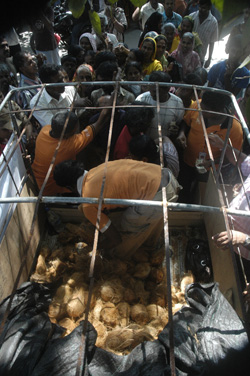The sharp rise in coconut prices has created a crisis. The government’s response has been to sell coconut produced in government plantations at a low price and to import coconuts to bring down prices in coconut. Neither of these are solutions to the problem. They are palliatives that cannot resolve the fundamental problem of inadequate production to meet consumer demand. Selling a limited amount of coconut at low prices will benefit a few consumers and unlikely to influence market prices by much. The import of coconuts may even worsen the crisis.
 |
| File photo : People throng round a vehicle that arrives at the Pettah market to sell coconut. |
The problem we witness today was predicted a long time ago. Sri Lanka’s coconut production has been on the decline for decades, while consumption was increasing with the increasing population. Consequently the exportable surplus of coconut products, mainly coconut oil, was declining. It was a matter of time when domestic consumption would exceed local production. The shock of high consumer prices should not have been a surprise.
In the last decade coconut the trend of declining coconut production was evident. In 2000 production was somewhat above 3000 million nuts at 3092 million nuts. It declined in the subsequent years to reach a low 2400 million nuts in 2002. Then there was aslight upward trend that took production up to around 2900 million nuts in 2008. Once again in 2009 production dipped to a little over 2700 nuts. This was below the required consumption level of approximately 3000 million nuts. Last year’s coconut production estimated by the Coconut Research Institute at 2791 million nuts would have been less than the consumption needs. Since coconut production has a seasonal cycle it is felt mostly at the end of the year when production declines. It is likely that there would be an improvement in the supply of coconuts when production peaks during the April -June season this year when the highest harvest of coconut is gathered.
What are the causes of the secular decline in coconut production? First of all it must be realized that the bulk of coconut production (about 75 percent) are produced in home gardens. Productivity is quite high on some of these garden plots but the capacity to increase production is limited by space, lack of high yielding plants and an inadequate thrust in promoting such production. Coconut production has declined owing to the felling of coconut trees for housing and industrial uses. The land area under cultivation has declined from around 444,000 hectares to about 360,000 hectares between 2000 and 2010. Most of the coconut area lost has been in the Kurunegala, Gampaha and Puttalam districts. There has been an increase in the cultivated areas in Badulla, Moneragala and Sabaragamuwa, but the extent of new cultivation has been inadequate to offset the area lost. This shrinkage in area cultivated is undoubtedly a prime cause for the reduction in coconut output. This is especially so as there has not been a significant increase in productivity. The lower relative profitability of coconut in comparison to other land uses have been a reason for coconut lands being put to other uses.
It would be quite inadequate to explain away the crisis in coconut production in terms of only the reduction in the extent cultivated. There are other underlying causes that have affected lower production and productivity. Diseases have affected coconut production in certain areas such as the wilts in Kalpitiya, Puttlam and Weligama in the South. Further much of the coconut lands consist of senile plantations. There have been inadequate replanting and under planting in coconut to ensure a more virile coconut profile. The profitability of coconut cultivation could have been enhanced had there been more intercropping on coconut lands. This has failed owing to the shortages of labour on the estates and small holdings. Inadequate resources for research in coconut have been a factor in Sri Lanka’s productivity falling behind that of India.
The research output at the Coconut Research Institute at Lunuwila has been modest. Further, it must be recognized that research in a perennial crop takes much time and that there are peculiar conditions associated with coconut research such as the possibility of cross breeding owing to wind pollination. There has to be a long term perspective on coconut research and far better funding is needed to attract high calibre of research scientists to the field.
Temporary palliatives to tide over the current coconut price crisis could be more harmful than helpful in resolving the fundamental issues confronting the industry. The import of coconut from abroad carries with it risks of crop diseases as has happened in the past. Increases in prices though a burden on the consumer could be an incentive for increasing fertilizer use, improvement of soil conditions and replanting. The import of coconut is therefore not in the interests of increasing production and productivity in coconut.
A long term strategy and plan is needed to boost coconut production. There have been several studies that have pointed out the needed new directions to resuscitate the coconut industry and research in the Coconut Research Institute. These require to be implemented rather that the immediate resolution of the problem of consumers. |


